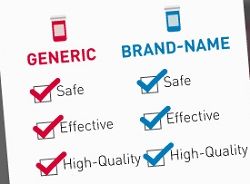A generic is a me dication that is indistinguishable from its brand-name competitor in terms of safety, quality, and results obtained from use.
dication that is indistinguishable from its brand-name competitor in terms of safety, quality, and results obtained from use.
According to the Food and Drug Administration (FDA), all medications (including brand names and generic medicines) must perform as described. Generics utilize the same ingredients as brand-name counterparts, and perform with comparable risks and advantages.
That said, individuals tend to not trust that generics perform as well as brand-name drugs. To guarantee quality, safety, and practicality, the FDA audits each and every generic drug marketed. This includes surveying scientific information on ingredients and clinical tests concerning performance. Generic lab facilities are as rigorously inspected by the FDA as big name pharmaceutical facilities.
1. Generics are gaining in popularity
The much lower cost of generic drugs compared with brand-name equivalents have made them an indispensable addition to inventory for drug stores such as FairPriceRx. The Hatch Waxman Act set up guidelines for producing cutting edge generic medication in 1984. Since then generics have gradually increased in numbers within the overall pharmaceutical inventory. By 2016, generics have established themselves as fully 89% of aggregate inventory, while accounting for only 27% of aggregate medical costs.
2. Generics are becoming less expensive
A 2016 examination by the Government Accountability Office of 1,441 generic drugs bears this out. The cost of a bushel fell 14% between 2010 and 2015.
As more lab facilities entered the generic marketplace the less expensive these items became. Market forces were also at work. For example, tranquilizer producers were forced to adapt to what the market dictated regarding price. Companies wanting bigger market share tended to increase sales volume while holding prices stable.
3. Production costs for generic generic drugs aren’t really less than the brand-name drugs. The difference is in pricing
An investigation of 40 different classes of generic drugs revealed that only seven classifications showed increases in retail costs that surpassed the inflation rate during the examination time frame. These included drugs marketed as infective specialists, anticonvulsants, antihypertensives, and thyroid hormones, and showed twofold digit cost increases.
4. Competition plays a huge role in generic drug pricing
As more entrepreneurs enter the generic marketplace pricing has become increasingly competitive. More competition invariably has resulted in pricing that sometimes falls too low for inefficient labs to survive. These are driven out of the market.
But that is not the entire story. While US antitrust laws shield shoppers from anti-competitive arrangements such as price fixing among suppliers it does not control the actions of specific corporations using ruthless business practices to gradually increase market share by driving out less financially sound competitors. According to the New England Journal of Medicine these profit-driven types figure out ways to legally corner the market and then capitalize on their monopoly standing by increasing price, even within the generic drug sphere.
Unfortunately, eye-popping price increases are not limited to monopolistic corporate interests. It has also happened in markets where there is healthy competition. For example, Ursodiol, a generic medication used to separate gallbladder stones, has been around since 2000 and is produced by a number of small corporations. Between 2000 and 2013 it retailed for $1 per unit. In 2014, for no apparent reason, the price jumped from $1 to $6. This egregious price hike was noted in Illinois and lawyers sued 3 makers of Ursodiol claiming the companies coordinated among themselves to successfully manage the outrageous price increase.
5. The FDA bottleneck has been settled
In an effort to quell the out-of-control price increases being noted among both name-brand and generic brands President Donald Trump has tasked the FDA to investigate and control rising medical costs.
On August 18, 2017, the President signed into law the Food and Drug Administration Reauthorization Act (FDARA), which includes the reauthorization of the Generic Drug User Fee Amendments (GDUFA) through September 2022. Congress first enacted GDUFA in 2012, following negotiations between the FDA and industry and with input from public stakeholders. Congress enacted GDUFA to ensure patients have access to safe, high-quality, and affordable generic drugs. GDUFA enables FDA to assess industry user fees to bring greater predictability and timeliness to the review of generic drug applications.
Shift Frequency © 2018 – Educational material
